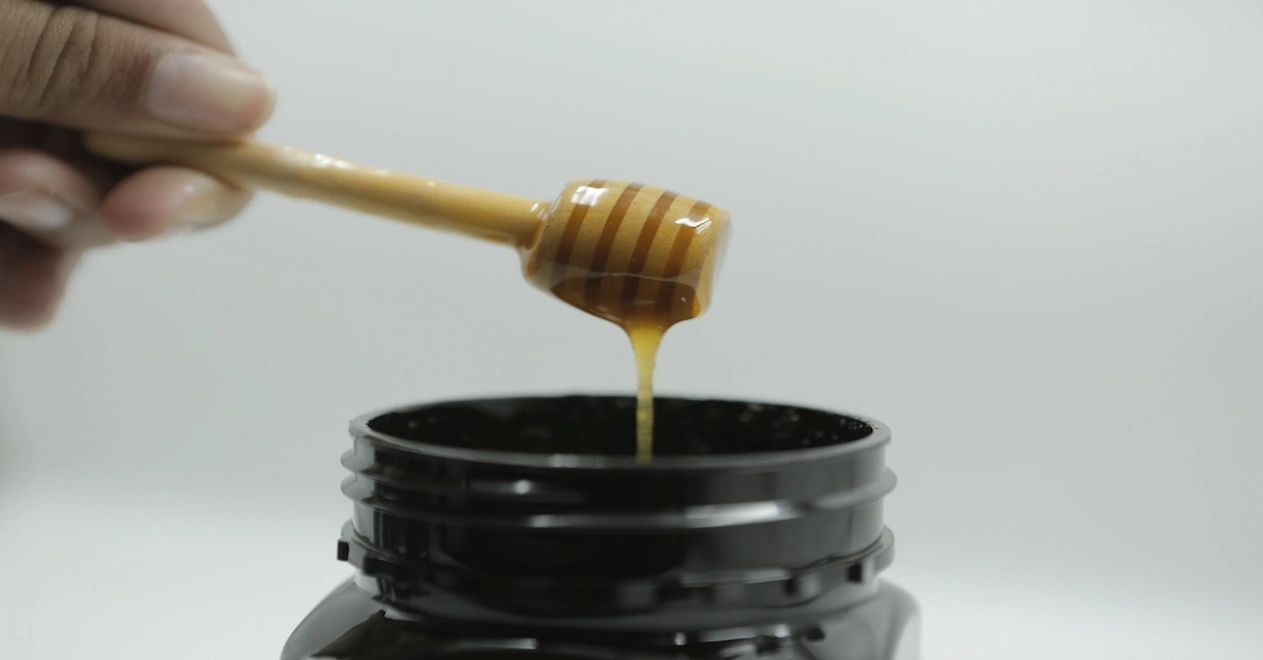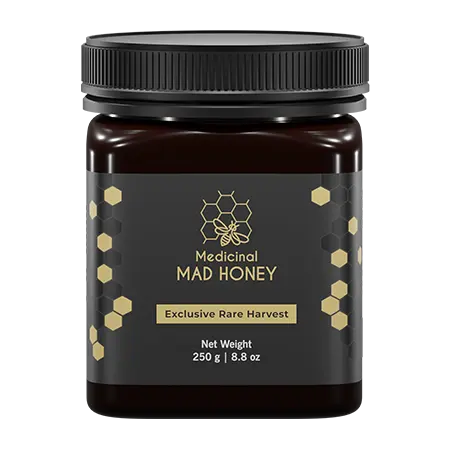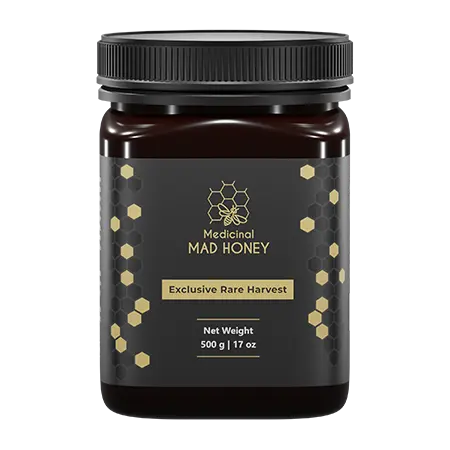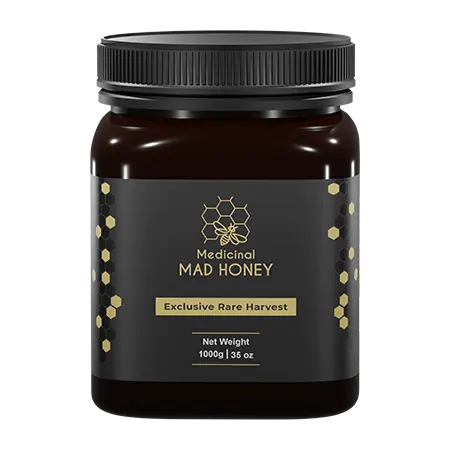
For many years, people have really liked honey. They like it because it’s sweet and tasty, and it’s also good for you and can be used in lots of different ways when cooking.
People from different places and times have all liked honey because it’s versatile and can be used in many delicious dishes.
We can use it to make things sweet, like drinks, desserts, and baked treats, and it gives them a unique, yummy taste.
But did you know that there’s more than one kind of honey? There are about 300 types of mad honey in the world. Among them, manuka honey and mad honey are two of their kind.
What is manuka honey?
Manuka honey, which is known for its amazing qualities, comes from the nectar of the blossoms of the Manuka tree (scientific name: Leptospermum scoparium).
This tree is found in New Zealand and some parts of Australia. The special nectar from this tree gives the honey its unique characteristics that make it different from other types of honey.
What really makes Manuka honey different from the rest is a substance called methylglyoxal (MGO). This substance is found in high amounts in Manuka tree nectar, and it gives Manuka honey its powerful antibacterial and antiviral properties.
MGO forms when a natural enzyme called l-dihydroxyacetone, which is present in the nectar of the manuka tree, changes chemically during the process of making honey.
Manuka Honey vs. Regular Honey
Here are a few differences between manuka honey and regular honey:
Sugar Content
One of the main distinctions between mango honey and regular honey is how much sugar they contain. Manuka honey usually has less glucose and fructose than regular honey, which can lead to a lower glycemic index. This feature makes Manuka honey a good option for people who want to manage their blood sugar levels.
Antioxidants and Bioactive Compounds
Both manuka honey and regular honey have antioxidants and special compounds that are good for your health. However, manuka honey often stands out because it has a lot of a compound called methylglyoxal (MGO) and other things called phenolic compounds.
These compounds give Manuka honey strong abilities to fight bacteria and reduce inflammation. Regular honey also has antioxidants, but the kinds and amounts can be different depending on the flowers the bees use.
Flavor and Aroma
Manuka honey has a special flavor that goes from earthy and a bit medicinal to rich and caramel-like. This unique taste makes it great for adding richness to foods like meats or mixing it with yogurt and oatmeal.
On the other hand, regular honey is generally sweet and can work well in lots of different recipes.
Texture
The texture of both manuka honey and regular honey can change depending on things like how warm it is and how it’s made.
However, manuka honey is often thicker and a little grainier, which is because it has more pollen and protein in it.
Cooking Uses
Because manuka honey has a strong taste, it’s good for recipes where its unique flavor is important. It’s great in things like marinades, dressings, and desserts like honey cakes.
Whereas regular honey’s milder taste makes it really useful for sweetening drinks, baking, and adding flavour without being too strong,.
Grading System
Typically, regular honey doesn’t have any specific grading systems. Factors like clarity, colour, and flavour influence its quality.
Whereas Manuka honey has a grading system based on its MGO content,. The higher the MGO level, the more powerful the honey is in terms of health benefits.
So, while people judge regular honey by its appearance and taste, they grade Manuka honey based on its health-boosting properties measured by MGO.
What is Mad Honey?
Mad honey is a unique kind of honey that comes from Nepalese rhododendron flowers. What makes it stand out is its ability to make people feel pleasant and different in a good way. The reason for its unusualness is the grayanotoxins.
Several people have reported that the madness makes them joyful and gives them lively yet calm energy.
People have been using this honey for a long time, thinking it might have some health benefits. It’s like a natural treat that can bring a smile to your face.
Manuka Honey Vs Mad Honey
Here are a few differences between manuka honey and mad honey:
Source of Origin
Manuka honey is made from the nectar of the manuka bush, which is mainly found in New Zealand and parts of Australia.
On the flip side, mad honey is a special treat from the beautiful hills of Nepal. Giant honeybees gather it from specific rhododendron flowers.
So, manuka honey has its roots in the bushes of New Zealand, while mad honey comes from the scenic hills of Nepal, thanks to those busy bees.
Composition and Properties
Manuka honey is not your usual honey; it’s packed with a powerful germ-fighting force called methylglyoxal (MGO). It’s supercharged antibacterial properties make it ready to tackle any germ that comes its way.
Now, mad honey is a bit different. It’s got this thing called grayanotoxin, which can boost your mood. It has psychedelic effects that can make you feel calm and happy.
So, while Manuka Honey is a germ-fighting hero, Mad Honey brings a unique mood boost with its psychedelic touch.
Flavor and Aroma
Manuka honey offers a unique taste that can vary from earthy and herbal to a bit bitter, depending on where it comes from and the type of manuka bush. It has a distinctive, rich flavor. \
On the other hand, mad honey is known for its psychoactive effects and has a bitter taste, often described as medicinal or slightly astringent.
So, while manuka honey brings a rich and distinct flavor, mad honey is recognized for its unique properties and a different kind of taste experience.
Mad Honey Vs Regular Honey
The key differences between mad honey and regular honey are:
Properties and Effects
Mad honey with grayanotoxin showcases its unique hallucinogenic or psychedelic properties that set it apart from conventional regular honey. Consuming mad honey induces a distinctive state of relaxation, affecting both the mind and body.
Also, it enhances concentration and fosters mental creativity, making it a subject of intrigue and exploration for those seeking altered states of consciousness.
In contrast, regular honey lacks the mind-altering compounds found in mad honey, particularly grayanotoxins. While it does offer mild soothing effects, regular honey falls short of delivering a psychedelic impact.
Taste and Appearance
Distinguished by its distinctive taste and colour, mad honey stands out as a unique honey variant that captures the attention of those seeking a novel culinary experience. Even in small amounts, the consumption of mad honey brings about a tingling sensation in the throat, adding to its allure.
Whereas, regular has a mild and safe taste palette. You can always choose regular honey if you don’t want to surprise your buds. Still, regular honey can be your comfort sweetener.
Mind-Relaxing Compound
Comparing mad honey and regular honey in terms of mind-relaxing compounds reveals a clear difference. Mad honey stands out with its grayanotoxin, bringing mind-relaxing effects that go beyond the usual honey experience.
On the other side, regular honey lacks grayanotoxin, providing a more traditional honey experience without any mind-altering effects. While regular honey has its physical benefits, it doesn’t deliver the unique mind-relaxing effects found in mad honey.
Sugar Content and Glycemic Index
Considering the sugar and glycemic differences, choosing between mad honey and regular honey boils down to dietary needs and health preferences. Mad honey, with its lower glycemic index, suits those monitoring sugar intake or dealing with diabetes.
On the flip side, regular honey, packed with more sugar, might be less suitable for those aiming to cut back on sugar consumption or managing diabetes. It’s a straightforward choice based on individual nutritional and health goals.
Manuka Honey vs Mad Honey vs Regular Honey
| Feature | Manuka Honey | Mad Honey | Regular Honey |
| Source | Produced by honeybees that pollinate the manuka trees in New Zealand and Australia. | It comes from the nectar of rhododendron flowers, found in the Himalayan regions of Nepal. | Derives from the various florals, depending on the regions and plants available to bees. |
| Unique Components | Contains methylglyoxal (MGO), which is believed to have antimicrobial properties. | Contains grayanotoxins, which can cause psychoactive effects if consumed in excessive amounts. | The composition varies based on floral sources and may contain antioxidants and other beneficial compounds. |
| Flavour Profile | It is distinct, with a rich, earthy taste and sometimes a bitter undertone. | Can have a bitter taste due to grayanotoxins; the flavor can be strong and unique. | Flavor varies widely based on floral sources and can range from mild and sweet to more robust. |
| Availability | Manuka trees are limited to specific regions where they grow and may be harder to find in some areas. | Found in regions with rhododendron flowers, primarily in the Himalayan region. | Widely available globally, with various types and brands found in most grocery stores. |
| Sugar Content (per 1 tablespoon) | Varies, typically 17–20 grams | Varieties can be higher than regular honey | Approximately 17 grams |
Final Thought
The choice between Manuka honey and regular honey ultimately boils down to your individual health and taste preferences. All three varieties offer distinct characteristics and potential benefits, and understanding your goals is key to making the right selection.





